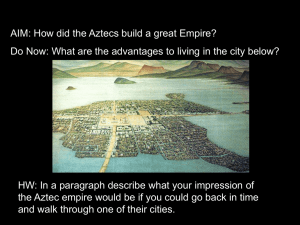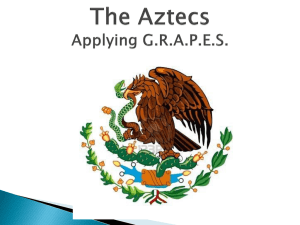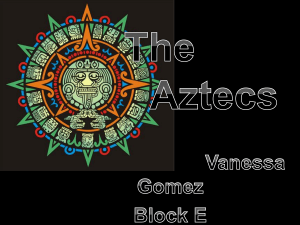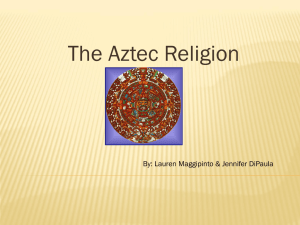File - World History
advertisement
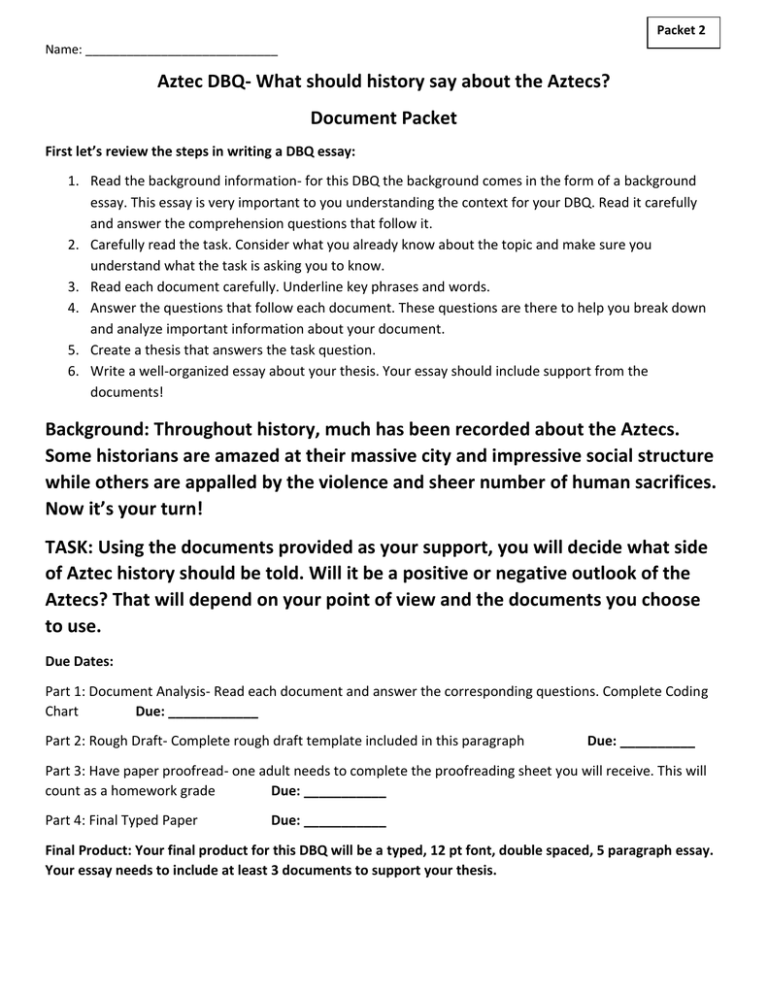
Packet 2 Name: ____________________________ Aztec DBQ- What should history say about the Aztecs? Document Packet First let’s review the steps in writing a DBQ essay: 1. Read the background information- for this DBQ the background comes in the form of a background essay. This essay is very important to you understanding the context for your DBQ. Read it carefully and answer the comprehension questions that follow it. 2. Carefully read the task. Consider what you already know about the topic and make sure you understand what the task is asking you to know. 3. Read each document carefully. Underline key phrases and words. 4. Answer the questions that follow each document. These questions are there to help you break down and analyze important information about your document. 5. Create a thesis that answers the task question. 6. Write a well-organized essay about your thesis. Your essay should include support from the documents! Background: Throughout history, much has been recorded about the Aztecs. Some historians are amazed at their massive city and impressive social structure while others are appalled by the violence and sheer number of human sacrifices. Now it’s your turn! TASK: Using the documents provided as your support, you will decide what side of Aztec history should be told. Will it be a positive or negative outlook of the Aztecs? That will depend on your point of view and the documents you choose to use. Due Dates: Part 1: Document Analysis- Read each document and answer the corresponding questions. Complete Coding Chart Due: ____________ Part 2: Rough Draft- Complete rough draft template included in this paragraph Due: __________ Part 3: Have paper proofread- one adult needs to complete the proofreading sheet you will receive. This will count as a homework grade Due: ___________ Part 4: Final Typed Paper Due: ___________ Final Product: Your final product for this DBQ will be a typed, 12 pt font, double spaced, 5 paragraph essay. Your essay needs to include at least 3 documents to support your thesis. Part A: Analysis of Documents. Read each document carefully and answer the questions that follow to help you break down each document Document 1: Primary Source Source: The Spanish conquistador Cortes writes a letter to the King of Spain, King Charles, describing what he saw in Tenochtitlan in 1519 The Market Goods This city has many public squares, in which are situated the markets and other places for buying selling. There is one square twice as large as that of the city of Salamanca [a large city in Spain]…where are daily assembled more than sixty thousand souls, engaged in buying and selling; and where are found all kinds of merchandise that the world affords… as for instances articles of food, as well as jewels of gold and silver, lead, brass, copper, tin, precious stones, bones, shells, snails, and feathers… There is also an herb street, where may be obtained all sorts of roots and medicinal herbs…There are apothecaries [herb and medicine shops], where prepared medicines, liquids, ointments, and plasters are sold; barbers’ shops, where they wash and shave the head; and restauranteurs, that [provide] food and drink at a certain price…There are all kinds of green vegetables, especially onions, leeks [and] garlic…fruits also of numerous descriptions, amongst which are cherries and plums, similar to those in Spain; honey and wax from bees…Different kinds of cotton thread of all colors…are exposed for sale in one quarter of the market…Large and small jars, jugs, pots, bricks, and endless variety of vessels, all made of fine clay, and all or most of them glazed and painted; maize or Indian corn, in the grain and in the form of bread. Great quantities of fish--fresh, salt, cooked and uncooked; the eggs of hens, geese, and of all the other birds I have mentioned, in great abundance, and cakes made of eggs; finally, everything that can be found throughout the whole country is sold in the markets. Order of the Market Place Every kind of merchandise is sold in a particular street or quarter assigned to it exclusively, and thus the best order is preserved. They sell everything by number or measure1…There is a building in the great square that is used as an audience house2 where ten or twelve persons, who are magistrates3, sit and decide all controversies that arise in the market, and order delinquents4 to be punished. In the same square there are other persons who go constantly about among observing what is sold, and the measures used in selling; and they have been seen to break measures that were not true. In all the markets and public places of the city are seen daily many laborers5 waiting for someone to hire them. The inhabitants of this city pay [greater attention] to style in their mode of dress and politeness of manner than those of…other cities…The manners of the people, as shown in their [interactions] with one another, are marked by as great an attention to [politeness] as in Spain, and good order is equally well observed; and considering that they are barbarous6 people, without the knowledge of God, having no [interaction] with civilized nations, these traits of character are worthy of admiration. Vocabulary Definitions Document 2: Secondary Source Source: Isaac, Barry L. “The Aztec ‘Flowery War’: A Geopolitical Explanation,” Journal of Anthropological Research, Cincinnati, OH: University of Cincinnati, 1983. Represents land conquered by Aztecs Aztecs warriors had the reputation of being fierce fighters, and most territories shown on the map were acquired by force. The Aztec armies fought with extreme violence and expanded their territories around Mesoamerica. When the Aztecs conquered a territory, they demanded tribute from the people living in the land. Tribute was a payment in goods and/or services. Items such as beads, clay bowls, maize, or clothing were often given. Territories that did not offer tribute could expect military repercussions (consequences). Some areas on the map were unconquered, and were left empty for the purpose of waging “flower wars.” During times of bad weather and famine (starvation), the Aztecs needed sacrifice victims in order to please the gods they believed would bring rain and crops. During these times, the Aztecs and their neighbors agreed to begin a “flower war.” The soldiers were told not to kill their enemies, but to capture them. Once each side had enough captives, the “flower war” ended. The captured soldiers were then taken for sacrifice by both sides in the battle. During a typical “flower war” the Aztecs would capture and sacrifice tens of thousands of victims. 1. What evidence from the text shows the Aztecs were fierce warriors? ____________________________________________________________________________________ ____________________________________________________________________________________ ____________________________________________________________________________________ ___________________________________________________________________________________ 2. What was the purpose of a flower war? ____________________________________________________________________________________ __________________________________________________________________________________ ____________________________________________________________________________________ ___________________________________________________________________________________ 3. How does the map support the fact that they were fierce warriors? ____________________________________________________________________________________ ____________________________________________________________________________________ ____________________________________________________________________________________ ___________________________________________________________________________________ Document 3: Primary Source Source: A seventeen year old Aztec Scribe records his impressions of a Sacrifice Ritual which is recorded and told to Friar Bernardino de Sahagun several years later in 1529) “When I saw this ceremony last year as a member of the priestly school, I was amazed by the physical beauty of the enemy warrior was killed at the end of the festival. This seasoned warrior, whom we change from a human into the god Tezcatlipoca, can have no blemish upon his body, and he is treated like our most royal family member during the long year leading up to his sacrifice. During that time he is given all the finest luxuries from the noble’s storehouses, including foods, clothes, teachers, women, and instruction… Many of us become attached to this living god, and a terrible sadness comes over some of the women when, at the end of the year, he is taken to Chalco and dismembered in public view.” 4. Who is the author and what is his purpose in writing about this sacrifice? ____________________________________________________________________________________ ____________________________________________________________________________________ ____________________________________________________________________________________ ____________________________________________________________________________________ 5. What do we learn from the account? ____________________________________________________________________________________ ____________________________________________________________________________________ ____________________________________________________________________________________ ____________________________________________________________________________________ 6. If a historian’s only evidence on Aztec sacrifice was Document 5, what might that historian say about the subject of Aztec Sacrifice? ____________________________________________________________________________________ ____________________________________________________________________________________ ____________________________________________________________________________________ Document 4: Primary Source 7. What does the image show-list at least 3 descriptors? _______________________________________ _______________________________________ _______________________________________ _______________________________________ _______________________________________ _______________________________________ _______________________________________ _______________________________________ _______________________________________ 8. Briefly describe the process of human sacrifice. ____________________________________________________________________________________ ____________________________________________________________________________________ ____________________________________________________________________________________ ___________________________________________________________________________________ Document 5: Secondary Source Source: Peter N. Stearns et al., World Civilizations: The Global Experience, AP Edition, New York: Addison-Wesley Educational Publishers, Inc., Longman, 2003. How have historians tried to explain or understand Aztec human sacrifice? Exaggeration Some historians that study Aztec sacrifice believed it was less frequent than we currently believe. They believe that Spanish conquistadors exaggerated the amount of sacrifice to serve their own political purposes. If they could make the Aztecs to be a violent and horrible people, it would be easier to defend taking the Aztec’s land and gold. A Religious Act Other historians believe that Aztec sacrifice was a religious act, central to the Aztec’s belief that humans must sacrifice their lives, the thing most precious to them, in order to receive the sun, the rain, and other blessings of the gods that made life possible. Political Policy Other historians disagree with both these perspectives. They view Aztec sacrifice as the intentional manipulation of the neighboring people. In other words, the Aztec rulers, priests, and nobility used war and human sacrifice for political purposes. They used the threat of sacrifice to terrorize their neighbors and subdue, or calm, the lower classes. If their neighbors and low class citizens were fearful of sacrifice, it was less likely that they would rebel against the Aztec rulers. Cannibalism? Other interpretations have been even more startling. Anthropologist Marvin Harris has suggested that Aztec sacrifice, accompanied by ritual cannibalism, was a response to a lack of protein. He argued that in Mesoamerica, which lacked cattle and sheep, there was a need for protein. The Aztecs, he believe would eat the bodies of their sacrifice victims in order to receive enough protein for survival. Other scholars have strongly objected to Harris’s interpretation of the evidence, which gave little attention to the ritual aspects of these acts. Still human sacrifice shades all assessments of Aztec civilization. 9. What does the phrase “intentional manipulation” mean in regard to the Aztec practice of human sacrificing? ____________________________________________________________________________________ ____________________________________________________________________________________ ____________________________________________________________________________________ ___________________________________________________________________________________ 10. What did Marvin Harris suggest about Aztec human sacrifices? ____________________________________________________________________________________ ____________________________________________________________________________________ ____________________________________________________________________________________ ___________________________________________________________________________________ 11. Which of the four ways to understand Aztec sacrifice do you think is most likely the real reason for sacrifice? ___________________________________________________________________________________________ ___________________________________________________________________________________________ __________________________________________________________________________________________ Document 6: Secondary Source Source: "Chinampa". Encyclopædia Britannica. Encyclopædia Britannica Online. Encyclopædia Britannica Inc., 2015. Web. 03 Nov. 2015 Chinampas, also called floating gardens, are small, stationary, artificial islands built on a freshwater lake for agricultural purposes. Typically they were made up building up a number of narrow islands, each averaging some 20 to 35 feet wide and some 325 to 650 feet long, using layers of vegetation, dirt, and mud. The lake provides the chinampa with a water source that moistens and fertilizes the island’s soil, supporting a highly productive form of agriculture. 12. Using the text, summarize how chinampas are made. ____________________________________________________________________________________ __________________________________________________________________________________ ____________________________________________________________________________________ ___________________________________________________________________________________ 13. Many people claim the Aztecs were the most advanced farmers to this time period. What evidence from this document would support that claim? ____________________________________________________________________________________ ___________________________________________________________________________________ ____________________________________________________________________________________ ___________________________________________________________________________________ Document 7: Secondary Source Image Source: Models created to represent the historical layout of the city of Tenochtitlan Tenochtitlan was a capital city built on a landfill (the earth had been dragged from surrounding swamp or brought by canoe from the mainland). There were two earthenware channels and one masonry aqueduct (a channel for carrying water) that carried fresh drinking water the three miles from the mainland to Tenochtitlan. It is believed that Tenochtitlan had one of the best fresh water delivery systems in the world at the time. The city supported a population of up to 300,000 people at one point and had a highly organized layout. 14. Examine the images, what evidence of advanced architecture and social organization do you see? Try to least at least 4 things. ____________________________________________________________________________________ ___________________________________________________________________________________ ____________________________________________________________________________________ ___________________________________________________________________________________ 15. If you had to write a paragraph about Aztec architecture and organization, what would your topic sentence be? What would be one piece of evidence to support your topic sentence? ____________________________________________________________________________________ __________________________________________________________________________________ ____________________________________________________________________________________ Document 8: Secondary Source 16. Explain how Aztec men and women became married. _________________________________________________________________________________ _________________________________________________________________________________ _________________________________________________________________________________ _________________________________________________________________________________ 17. What punishments and discipline systems were found in Aztec culture? _________________________________________________________________________________ _________________________________________________________________________________ _________________________________________________________________________________ _________________________________________________________________________________ Part B: Coding Chart- Each Document tells either a positive or negative view of Aztec culture. Code each document in the chart below as Positive or Negative and give a quick explanation why the text supports your view. Document Positive or Negative Evidence from text or Reasoning for Code 1 2 4 5 6 7 8 Part D: Create your thesis- Based on the chart above, what is your opinion of the Aztecs? Do you believe a positive or negative view of the Aztecs should be told by historians? Examples: Positive View Thesis: While many remember the Aztecs as a cruel civilization, the Aztecs should be remembered as an advanced civilization because of ________1________, ________2___________, and _______3_________. Negative View Thesis: While many remember the Aztecs as an advanced civilization, the Aztecs should be remembered as a violent and cruel civilization because of _______1________, ___________2__________, and ___________3__________. Your Thesis: _____________________________________________________________________________ ________________________________________________________________________________________ ________________________________________________________________________________________
